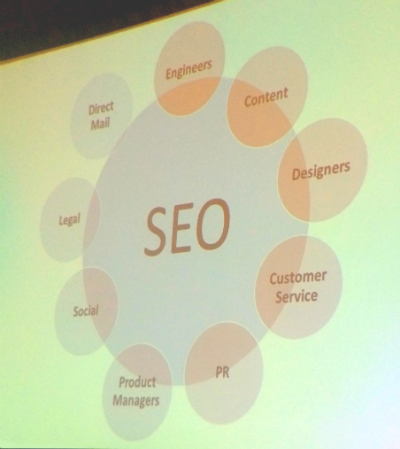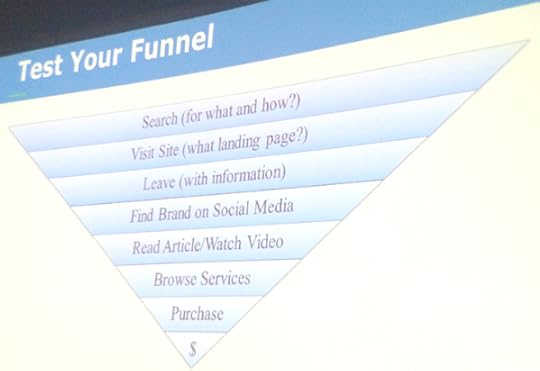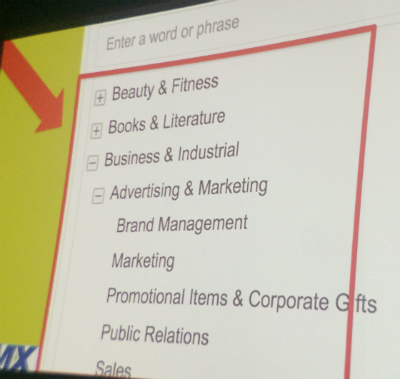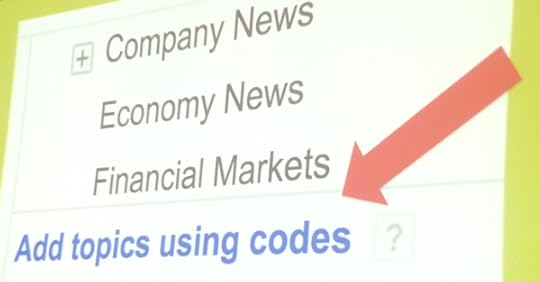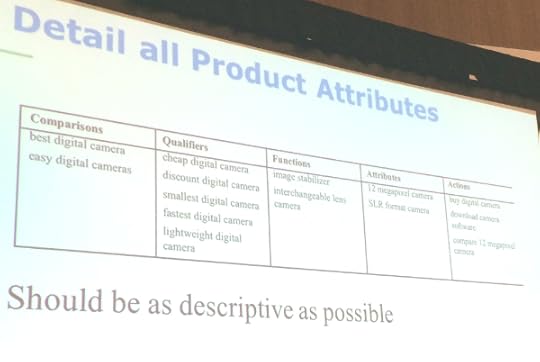Bruce Clay's Blog, page 32
March 4, 2015
Mobile App Indexing, Deep Linking & Development #SMX
Mobile App Indexing, Deep Linking & Development #SMX was originally published on BruceClay.com, home of expert search engine optimization tips.
Developing an app is a resource investment, but one that can pay off in time if done right. In this SMX West session ( “Search Inside the App”), Google’s Mariya Moeva talks about how Google is looking at apps, and the opportunities they afford. She is joined by digital marketers Ian Sefferman and Justin Briggs. Briggs and Sefferman work in app development and analytics, and they will share their latest insights straight from the trenches.
How Google is Thinking About Apps
Mariya Moeva is a Google Webmaster Trends Analyst and she’s going to share insights on how Google perceives apps. Apps are very important — there are around one million apps in the Google Play store. Downloads are in the tens of billions. According to certain studies, people are spending more than 80 percent of their time on mobile in apps.
Moeva traveled from Switzerland to San Jose for SMX West 2015. It was a long journey and she says that apps played a significant role in her travel.
“When I got started I used the Swiss railway app to buy a ticket for a train. I used the app instead of a website because it stores my itinerary, my payment details, etc. I checked in for the flight using the Swiss Air App. If I open the app and shake the phone, my boarding pass appears. Then on the plane, I read articles on my Pocket app and studied German through another app. I spent quite a bit of time on apps. I do this every day and I’m pretty sure this is true for all you,” Moeva says.
She points out that apps give your business a ton of information about your users. Geo location, their contacts, etc. There are so many possibilities for what you can do with an app.
Imagine if you had an app that could tell customers that as they’re passing a store that, inside, there is a discount on an item they’re interested in. Or imagine you’re a news outlet, and you could push news your readers are uniquely interested in straight to them on their phone via push notifications.
There are a lot of things, like these, that you can do using apps that you can’t do if you only have a website.
But on the other hand, Moeva says, apps are clunky. They require a significant up-front effort for your development team. Also, there’s a barrier to entry for customers and they must install the app and/or create an account. She shares a startling fact: people on average install 26 apps on their phone (many apps are left out), and 5 percent of apps drive 92 percent of all app downloads. (Tweet this!)
She invites developers and digital marketers to visit a recently launched Google resource to learn more at g.co/developersearch.
App Development Recommendations
Work as a team. It takes two to index an app.
Google is working on several new features that focus exclusively on apps. Sign up to be an app features tester and learn by doing: http://bit.ly/wmt-app-features (this program is brand new; just went live today!)
Remember that Google wants to help.
Deep Linking and Search Today
Ian Sefferman is the general manager of App Store Analytics at TUNE. He is going to share some of his insights on deep linking.
He begins by noting that app store search today is app-based rather than content-based. That means that app developers should focus on title, description, keyword field, icon, screenshots, rating, reviews, etc.
As far as user behavior is concerned, he points out that consumers are continually installing apps. People are looking for apps on an ongoing basis and at any given time, most of your users will be fresh users who have installed an app in the last month.
Where did U.S. iPhone and Android users find the last app they downloaded? The primary way is searching through the app store.
Deep linking allows one app to connect directly to a piece of content within another app. For example. if you’re looking at Google Maps, you can request Uber from within Google Apps. Shefferman says deep links are like the webpage equivalent of a website.
Another example: Let’s say Airbnb wants to promote a certain room. In this example there could be an ad that sends a user the app store to prompt them to download the app, then, once the app is downloaded, the app will open straight to that specific apartment. This is called referred deep linking.
Deep linking tomorrow will feature organic discovery at its core: helping connect consumers and apps before the app has been installed. APIs will form the backbone of the system between apps and crawlers.
How to Get Your App Indexed in Search
Justin Briggs, digital marketer and CEO of Briggsby, opens by saying search is fundamentally shifting. We’re changing how the web works, moving away from the simple return of web pages. We’re looking at a search experience that’s elevating into an interface. There’s an increased ability to take action and have answers without web pages.
Briggs envisions a future where apps can assist you in life. He imagines being able to tell your device:
Take a note: ‘idea for a movie Jaws in Space.’
Remind me to check the oven in five minutes.
Send a message to Paula: ‘I’m on my way.’
Navigate to Morten’s apartment.
Send an email to mom.
Set an alarm.
Call me a cab.
All of these commands would happen via apps, and would be relevant, obviously, to wearables, too.
Check out Briggs slide deck for coding directions to get your app discovered:
March 3, 2015
14 Shady SEO Agency Lies & Client Crimes
14 Shady SEO Agency Lies & Client Crimes was originally published on BruceClay.com, home of expert search engine optimization tips.
It’s critical to know what your service providers are actually doing when it comes to SEO, explains Motoko Hunt, long-time search marketing consultant and the chairman of SEMPO. In this SMX West session, “Avoiding Shady Search Marketing Practices,” she breaks down some of the common ways shady digital marketing agencies deceive unwitting clients.
SEO Lies Shady Agencies Tell
Below, Motoko lists some of the common ways shady agencies trick you.
“We build SEO-friendly sites.” Sure, but you have to ask for it.
“We have the best search team.” Some search teams forget to remove robots.txt and forget to unblock a site for months. Are they really the best?
“The performance has improved by 200 percent.” But what does 200 percent mean? What are the actual numbers, two to six?
“Here’s the high level report.” This means you are not going to see the detailed report because it show s all the problems with your campaign.
“We have to own the account.” Because the last we need is for you to check our work. Because if you do, you may not like what you see.
“We guarantee a No. 1 Ranking.” You mean for branded terms or long-tail keywords?
“This is what you get. It doesn’t matter what you need.” They disregard your campaign goals.
“Our contract is a minimum of five years.” If you try to back out before, the shady agency will tell you they created the website and you don’t own it. If they do let you keep the website (that you paid for), they’ll threaten to remove links, or confiscate data and history.
“That’s Extra.” Everything turns out to be extra and the site takes longer to launch and the budget skyrockets.
“You’ll get custom templates.” Once the site launches, you find out they’ve been using pre-created templates even though you paid for the premium template.
4 All-Too Comon Client Crimes
Crime 1: Having little knowledge. Knowledge is power. Do your research and empower yourself.
Crime 2: Lacking goals. Don’t ever approach a project or campaign without goals.
Crime 3: Being too cheap. Budgets are limited, but you can’t expect to get 1 million dollars worth of project work done for $1,000. You need to be realistic. If your budget is limited, prioritize your goals and start with the most important ones.
Crime 4: Being naïve. Don’t trust blindly — check the details. Read the fine print and negotiate the contract until you’re happy.
3 Solutions!
Ask for five references (and check them!)
Search your potential agency’s name and read reviews.
Always ask for the detailed service plan that clearly explains the agency’s terms of service and methodology.
SEO Automation for Expansive Websites #SMX #14A
SEO Automation for Expansive Websites #SMX #14A was originally published on BruceClay.com, home of expert search engine optimization tips.

Michael Nguyen, Director of SEO at Connexity/Shopzilla, on stage at SMX West 2015
This SMX West 2015 mini session is a presentation grounded in the belief that you can automate everything for SEO and directly integrate it to your products. This is especially important for large websites. Michael Nguyen, Director of SEO at Connexity/Shopzilla, is our presenter.
SEO for Large Sites
What is large? Too big to fit in your head. Examples are networks of sites and sites with thousands and millions of pieces of content. Enterprise sites and long-tail businesses are also to be considered large.
Large sites have big problems. Good things about large sites include domain authority and a lot of content. But problems include:
Too many products!
Duplicate content and canonical issues
Crawl efficiency
Shifting inventory
Shifting search demand
This is a discovery optimization problem. How do you make it easy for users and search engines to get to the content you care about. The solution is organizing content, surface content and improve the content value.
Checklist if you’ve inherited a large site and run into the problems:
Identify valuable content: figure out the pages/products that are valuable
Keyword research: natural language and not jargon
Site architecture: manually create a taxonomy with the help of info architects and keyword research
Content for category pages: manually create content for landing pages to merchandise products/content
Flag dupe content: audit content and map duplicate to a canonical URL
Deal with stale inventory: Audit content/ products for removal and canonicalization. If it’s temporary: keep it up; if it’s permanent: redirect or 404
Deal with pagination and facets: create rules for managing crawl and technical SEO. Control the crawl.
Promote high quality content: remove the junk, market the good, and be selective.
Build category linking support: link to categories and subcats in all key areas. Flatten the crawl architecture by linking across deep pages. Remember links come in from everywhere.
You’re done! … Not so fast. If you’re doing the whole process by hand, you find you run into changes as you go. Change is constant. Inventory and business changes. Not a one time deal. Doing it manually doesn’t scale for large operations. Many variables to manage. The answer is automation. Scale your operation with technology and process.
How to Automate
1. Identify routine tasks. Figure out how often you do a task. Start small. Automate very small tasks to start.
2. Improve operational efficiency. Focus on speeding up processes.
3. Test and validate. When you start to trust an automated system, check to make sure it’s doing the job right.
4. Keep in mind the bigger picture.
Great SEO Platforms
Characteristics of a great SEO platform:
Make the core product better
Enable testing and experimentation
Leverage big data
Combine data and expert intuition
Dynamic content management
Related searches
Page scoring: if you can evaluate content with KPIs, you can direct users to pages that matter the most. This is business-specific scoring
Duplicate content classification: ensure that you only promote your most useful content
Backlink classification: easily audit large amounts of backlinks
Get to Good Enough
You can’t ever get to perfection. You’ll never automate yourself out of a job. Get to good enough first. Try to get value out of every step. APIs are your friend; you don’t always have to build things in-house. Offload tasks and data gathering (AuthorityLabs, GA/GWT, Deepcrawl, Botify). Utilize your internal search engine to understand search engine concepts like keyword data. Leverage data and search science, like books on informational retrieval and open source tools (sentiment analysis, spam filters, duplicate content classifiers, and he gives Mahout, Hadoop, HBase as examples). Build a feedback loop into your system to generate data, make judgments, have it continually understand what’s going on and loop it back into the system.
This is the future of SEO.
Dr. Pete On the Ever-Changing Nature of the Google SERP
Dr. Pete On the Ever-Changing Nature of the Google SERP was originally published on BruceClay.com, home of expert search engine optimization tips.
Moz’s SERP scientist, Dr. Pete Meyers — commonly known simply as Dr. Pete — takes the stage to discuss the changing nature of the Google SERP, and how SEOs can respond.
Trying to see how Google changes day over day is very difficult.
Remember when there were ten blue links? Today, you have to search for some pretty boring things to see just those ten blue links … Meyers uses the example of Nebraska unemployment. Most SERPs are filled with direct answers, ads, images, site links, paid shopping, local enhancements, video thumbnails, etc. Only 3 percent of SERPs have ten blue links alone.
4 Ways SEOs Can Approach the Ever-Changing SERP Without Missing a Stride
1. We have to get away from the “We’re No. 1″ mentality. Miss all the SERP enhancements and you’re missing out on plenty of opportunities. You’re not seeing the SERP for what it is. You need to understand the SERP in context and know what’s going in real searches.
2. Don’t be bot food. It’s not going to work anymore. This knowledge is far too easy to repurpose into a simple answer. You can’t survive on easy answers.
3. Plant evergreen content and harvest results. You have to start putting money into content that cannot be easily scraped and repurposed.
4. Look at Mobile SERPs for a Sign of Future Desktop Changes. He quotes Google’s Principal Designer Jon Wiley: “we launched some pretty big design improvements for Search on mobile and tablet devices (mobile first!). Today we’ve carried over several of those changes to the desktop experience.”
Google knows it has to carry to a mobile market – they are scared of what will happen to CTR if mobile is not friendly. Based on this quote from Wiley, Meyers reasons that SERP changes happen to mobile first — therefore it’s in the SEO’s best interest to constantly be monitoring the mobile SERP landscape.
Injecting SEO Into Your Organization’s DNA #SMX #14A
Injecting SEO Into Your Organization’s DNA #SMX #14A was originally published on BruceClay.com, home of expert search engine optimization tips.

An intro slide of Micah Fisher-Kirshner’s presentation. SEOs don’t market to robots. SEOs market to people.
It’s Google’s job to emulate what consumers want without knowing our sales data. We need to convince a copywriting team to write better than the competitors because Google is using that info to compare you to your competitors. We try to convince our PR teams to do things, our engineering teams to do things. In this mini session at SMX West 2015, Micah Fisher-Kirshner, Senior SEO Manager at Zazzle Inc, dives into tactics to get a whole organization working to accomplish SEO initiatives.
Have you had to deal with last minute changes for designers? Or change 302s to 301s, resulting in more work for IT? All this extra work stems from not knowing the importance of minutiae and how these small things affect SEO. It’s the SEO’s job to train other teams. Explain to the designer why it matters to have text vs. text in an image and to have alt text. Explain the the IT team the importance of a 302 vs. a 301. To the data team, explain the importance of page-level data and parameters at a page level.
They’re owned by different business channels, like engineering, IT, social media, copy, design and project managers. Everyone in an organization needs to know what matters to Google. Yes, everyone.
SEO is a grey area of many other teams and doesn’t stand on it’s own.
Many teams own what SEO cares about. The higher up in the funnel SEO is injected, the less need to rework on success.
Action items:
Success is when people come to your desk asking questions. And when they come up with ideas that make you jealous, then you’ve really succeeded.

Micah Fisher-Kirshner
Communication key: ask yourself if your parents would get it? Be crystal clear in explaining the SEO needs, especially to non-techies. Also, don’t come across as though you’re dumbing it down. Repeat yourself. Explain jargon as you’re going along. He points to Neil Tyson DeGrasse as an example of that.
Tactics:
Jargon jar where you put money in the jar when you use jargon in front of someone from another team. Have fun with it by putting the money toward causes or a movie day or coffee fund
Another indicator of success is when you learn their jargon.
Give someone options. If a 301 isn’t possible, give them the canonical tag.
Consistently ask how we can help them on their projects.
Show proof of success when the things you implement together succeed.
True success is an integrated team!
The Power & Persuasion of Infographics #SMX #14A
The Power & Persuasion of Infographics #SMX #14A was originally published on BruceClay.com, home of expert search engine optimization tips.

David Wallace, CEO of SearchRank, at SMX West 2015
David Wallace is the founder and CEO of SearchRank. He’s going to present a mini session at SMX West 2015 on best practices for marketing with infographics.
Infographics are AWESOME! We’re overloaded with information today. We’re visually inclined and with infographics we can learn quickly and digest info.
The average person is subjected to 174 newspapers worth of info every day. 99% of sensory information is filtered out by the brain almost immediately. That means 1% of info actually gets to the brain. Publishers who use infographics in their content marketing strategy grow in traffic an average of 12% more than those who don’t.
Infographics aren’t new. They date back to the caveman days when stories were told on walls.
There are four styles of infographics:
Static: large image files
Animated: huge animated gifs
Video
Interactive
Infographic design mistakes:
Ugly: no matter how great the idea or topic of the infographic, poor design will kill its overall effectiveness
Display size: size matters. Allow for a larger version to be viewed.
Grammar and spell check: Someone is going to call out any errors to spelling and grammar
Citations: list sources! it adds credibility
Actually an infographic! Some things that are passed by their creators as infographics actually aren’t.
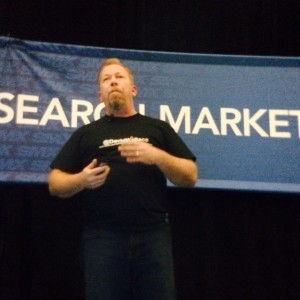 Avoid common blunders. Always:
Avoid common blunders. Always:
Include social sharing buttons on the page so it’s easy for people to share
Share it on your own social networks to bring awareness to your content
Social sharing right vs. wrong:
Link back to original post
Include short description
Utilize hashtags
Include images
Call out influencers
Retweet older infographics if a trend or current event makes it relevant again
On Pinterest:
Link back to original post
Post to topically relevant boards
Include a short title and description of infographic
Takeaways:
If you aren’t utilizing infographics you are missing out
Don’t compromise on infographic design elements
Make it easy for users to share and repost infographics
Don’t forget to share on your own social network
Measure for success, rinse and repeat
Intel’s Philosophy and Approach to Big Brand SEO #SMX #14C
Intel’s Philosophy and Approach to Big Brand SEO #SMX #14C was originally published on BruceClay.com, home of expert search engine optimization tips.
Intel is a Fortune 50 company present in 63 countries with 110,000 employees — in other words, they have a large global footprint. Today, in the SMX West session “Extending the Value of Search Beyond Your Website,” Digital Intel Digital Marketing Manager, Laura Ann Mitchell, and Global Strategies Sr. Vice President, Ken Shults, will discuss how Intel approaches SEO.
How Intel Approaches SEO
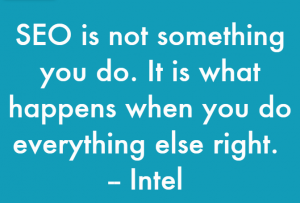 Mitchell explains that Intel is aggressively pursuing new opportunities with new products for new audiences in new markets. Mitchell is invested in keeping things engaging. Intel has to leverage search to understand what consumers are looking for, what their pain points are and how Intel can reach them, she says.
Mitchell explains that Intel is aggressively pursuing new opportunities with new products for new audiences in new markets. Mitchell is invested in keeping things engaging. Intel has to leverage search to understand what consumers are looking for, what their pain points are and how Intel can reach them, she says.
Organic search to Intel websites has increased by an average of more than 20 percent per year since establishing a centrally managed SEO program in 2008. Organic search brings half of all referrals to Intel.com.
In 2014, there was a 9 percent drop in organic traffic at Intel, causing the SEO team to ask: “Have we reached maximum potential?”
Understanding that a one-dimensional approach is myopic and presents no true opportunities for sustainable growth, Intel decided to branch out into other arenas.
Shults points out that there have never been more ways to engage with customers than now. And while every path is unique, search almost always plays a role in the journey, giving search a unique position among marketing channels.
Looking at search data, for example, lets him see that that gaming is by far the biggest use case for the laptop audience. He also can see that interest in tablets for children surges to five times its normal amount during the holiday season. This information helps shape the marketing messages and choices.
At Intel, the different teams (paid search, display, editorial, content creation, SEO and social) meet together weekly to learn from each other. All of this plays into Intel’s philosophy on digital marketing: “SEO is not something you do. It is what happens when you do everything else right.”
Takeaways
Leverage search to understand what consumers are looking for, what their pain points are and how Intel can reach them.
Organic search is alive and well (more than half of referrals come from organic search for Intel) but don’t put all your eggs in one basket if you’re looking for sustainable growth; branch out and make sure your search strategy has layers.
Looking at fluctuations in search volume, and who is searching for what when, can help guide marketing messages and choices.
Your team should never be on an island! At Intel, paid search, display, editorial, content creation, SEO and social teams work together, and are constantly learning from one another.
Keywords Are Dead – Research for Entities & Audiences #SMX #13C
Keywords Are Dead – Research for Entities & Audiences #SMX #13C was originally published on BruceClay.com, home of expert search engine optimization tips.
This session at SMX West 2015 “looks at the shift away from the keyword-based world, with tips and strategies for both SEOs and SEMs for thriving in a concept-driven world.”
Danny Sullivan, Search Engine Land’s editor in chief, is this afternoon’s moderator. That says something about this topic’s significance to current trends in the search marketing industry.
Sullivan says that in the old days, we used to fire up the Overture keyword tool or the GoTo keyword tool and see all the words people were searching for. What’s the joke about the SEOs that walk into a bar? a pub? a watering hole?
As we know, the data given by a straightforward keyword tool isn’t enough today. You have to combine many approaches, getting to the audience and intent with different kinds of tools and data available to marketers today.
Keywords and SEO: The Changes
Kate Morris, Director of Client Strategies, Outspoken Media (Note: Her slide deck is available here.)
Kate Morris started in this world in PPC. It was keyword heaven. You knew exactly what everyone was doing all the time. Now, 100 percent on the organic side, the past three years have been so different, and the biggest thing has been the change to keywords and how to approach them. Here’s how to deal with them.
First, definitions. Keywords (query) and concepts (topic, info that you’re looking for).
For any one keyword there could be multiple concepts, and vice versa. The one keyword vs. lots of concepts is typically what we run into as an issue. For example, “au pair in Georgia” could be:
Search engines are moving from relying on just the query to using a number of data points to determine the best results. The query doesn’t tell the search engine everything. Geolocation, personalized search, this has been going on a long time. Now there are device types, schema — a lot more being fed into the big machine to get the best results.
The old process was very specific to keyword-specific things, and the problem with that today is that you can’t report on keywords. Keywords don’t translate to the bottom line. And the process has changed in a way that starts with site structure and optimization. The technical details are so important; SEO will never die because sites ban crawling or set up redirects wrong, have duplicate content, etc.
Has anyone in here been an in-house SEO for the same company for more than five years? One person in this room of 100 raises their hand. It’s very rare. Lots of people touch a project.
Change 1: Searcher Behavior
Mobile Internet Usage! So much higher than everything else. Facebook the app has a lot to do with that. Think of all the apps that connect to the Internet. That’s part of the volume of time spent on the Internet.
The question for SEOs is how many people are searching on mobile. Morris went looking for these numbers and couldn’t find them. She even asked a Google employee. So! She took a sample of data from her clients (14 sites) to get some kind of data.
Here’s the breakdown of her sources. Note that the B2B data is only two sites. The announcement a few days ago about Google using mobile friendliness as a ranking signal for mobile search shows that.
Google says that about 25% of queries have a Knowledge Graph result.
Change 2: SERPs
Longer results pages. She’s seeing search results pages with 100 organic results on the first page.
Search engines are identifying if a searcher needs information or a service. Google will try to present both types of results.
For the query “buy a house” — it has a transactional word in it, but people aren’t buying houses online. 89 percent of first page results are info; 70 percent of top 10 results were serving purchase behavior.
Change 3: On-page Targeting
Who counts how many times a world shows up on a page?
Check out this list of multiple keyword versions:
Morris took the top 10 terms in the slide above. Tweet at @katemorris if you want to see the full Excel sheet of data.
Result: Capital One. 10/10 Page 1 rankings. One keyword variation in title, three keyword variations on page.
Result: Bank of America Calculator: 10/10 Page 1 rankings. One keyword variation in title. Eight keyword variations on page.
Result: BofA product page: 3/10 rankings. Three keyword variations in title. Six keyword variations on page.
Result: Bank Rate article: 6/10. One kwd variation in title. Three variations on page.
There’s not a common trend. Conclusion: You still need to know keywords as a pro, but on-page keyword optimization isn’t as necessary.
Schema Markup
Search engines need data for this to work. You have to supply that to be included. Help them help you. The way people make money on the Internet is getting in before the market is saturated.
Google says that it does not use markup for ranking purposes but it can affect how much traffic you get. A Searchmetrics study of sites show that with schema, on average, they got better positioning in SERPs.
Change 4: Analytics
We all cried after [not provided]. Search engines went, “meh.” 85% of traffic is not provided. What irritated her was that when you went into Google Analytics, the Keywords had gone missing under Campaigns.
Focus on the demographics, interests and cohort analysis data. That’s the stuff you need to start knowing. Google is trying to give that to us. Marty Weintraub, up next, will get into this.
Know that what Google is going for in all these changes is to answer people’s questions and give the best results possible. They want more search share. Fighting spam is another strong reason behind the changes. Oh yeah, and money. Of course.
How Do I Deal With This?
Our world changes all the time. Take a breath. It hasn’t changed that much.
1. Work on goals. Company specific goals, not based on keywords but centered on traffic and conversions.
2. Seen this? Dana DiTomaso’s video from MozCon2014.
3. Don’t stop doing keyword research. It’s still one of the best pieces of info you can get regarding what people are looking for.
4. Think about user intent. If a keyword doesn’t match what you offer, don’t worry about it!
5. Add audience research to your audits. You can’t know what content to build if you don’t know who you’re talking to. You don’t know the concepts that you’re part of if you don’t do this. We suck at talking to people as search marketers. The best content ideas will come from your
6. Mark up all the things.
7. Test your funnel.
8. Get to know and love content audits.
Get help here: http://www.content-inventory.com/content-inventory-templates/
Rest in Peace Precious PPC Keywords?
Marty Weintraub, Founder & Evangelist, aimClear
Marty Weintraub is up. He says Google has been trying to take away keywords for years and years. The good news is that everyone who has been learning to sell with psychographic data, you’re in heaven because you can sell with this stuff.
Google has been on a pogrom to depreciate granular keyword data, what we see and what we can use to target for years. Now we have to use the Force — put on the blinders and feel it.
Here’s a tour of targeting in display networks and the data you can get from it. Punchline: THINK LIKE A SOCIAL MARKETER.
Affinity audiences in Google AdWords is the tool that the first half of his presentation uses. http://adwords.blogspot.com/2014/10/i...
1. Demographics
Look at topics. There’s a list of topics called “topics codes.”
In the age of disappearing organic keywords, use paid keyword data. Click into the topics code list from Google Display Network. Facebook has the equivalent.
support.google.com/adwords/answer/156178 — an outline of the taxonomy of topics. Google gives this to us, whereas Facebook doesn’t.
Keyword List Targeting by Interest
Look at in-market audience in AdWords. This is about people actively looking to purchase things. Keep in mind that Google is a search engine. They tap deeply into what people are searching for.
Affinity Audiences
Google made affinity audiences to support TV advertisers. If you advertise on TV, look at affinity audiences (ex: bargain shoppers, winter sport enthusiasts). Clearly the application is beyond TV advertisers.
Facebook has the equivalent as “Interests.”
There’s an exciting new button “Create custom affinity” at the bottom of affinity audiences. Google says they’re factoring in consumers’ most recent passions and ongoing interests — they use all the data and line up the audiences to categorize users in various ways.
Google wants you to put in at least five URLs and interests (combined!) to create a custom affinity audience. The more you add, the more discriminating the data. Even if you never run an ad on Google’s network ever, you use this AdWords tool to discover your audience. This is your new content keyword research tool because it clusters the themes of your searchers.
Psychographics + Search
The takeaway is that the psychographic marketer is in the Google role now. Let go of the keywords and think like a social marketer. Make audiences just like you do in Facebook.
When you market your content based on and amplified by data like this, you introduce people close to the sale. Then you remarket to them to capture the rebounds. You can use this data for Google+ post engagement ads.
In Facebook you’re limited by what’s there — the interest or behavior is there or it’s not. In Google, you can type anything in the box and Google will tell you about the demographics (age, gender, parental status) and the top websites on the topic.
This is an exciting time for us, marketing brothers and sisters! Weintraub asks the audience for an “AMEN” and the audience obliges enthusiastically! (Yes, you want to know Marty Weintraub, a dynamo mind and presenter in the industry.)
Note: This is highly vertical dependent and won’t work for everyone the same way.
Dynamic Search Ads (DSA): He suggests looking into this in AdWords. Google makes up the headline and chooses the keyword. Google crawls your site, makes up categories. Here’s a presentation Weintraub recommends viewing on the topic of DSAs. http://www.slideshare.net/SearchMarketingExpo/how-to-make-dynamic-search-ads-work-for-you
PLAs
Weintraub has concerns with Google PLAs. Google PLAs are eating brand SERPs. PLAs = Thievery. “PLAs steal intent-driven clicks from other PPC ads.” –Larry Kim, Wordstream
Suffocating Rules:
You can’t market services with PLAs.
Inventory has to be verifiable by Google real-time.
Buy Online & Pick Up in Store (BOPIS) is the only ecommerce option.
Inventory can be verified at the regional or warehouse level if you deliver it to the buyer’s home.
The workaround:
Put up a Magento site. Test it in store.
Conclusion: Bye-bye PPC staff?
The level of employee required to run Google’s machine is going down. Creative is going to be the driver and difference maker. Your job is about maintaining the machine. Know the evolution of search ads, contextual targeting, PLAs, custom affinities.
Future:
Less transparency
If you’re someone who wants to dress up like a furry, you can target your people!
Takeaways
Audience question: How do you silo based on concepts and not keywords?
Weintraub: For years in social media we’ve been crafting content based on the audience. Look at the proportional interest for combinations of psychographic audiences. Look at how many cookies are available on Google to market to the proportional audiences. Advise organic content strategy based on audience available on paid.
Morris: Marketing is applied psychology. We have to understand what people are looking for by taking certain inputs. If you take a lot of input on the form of phrases into the paid keyword tool, it will categorize it. How will the content you’ve made, your competitor’s content, investigate what people are searching for — not easy to answer and why we’ll continue to have jobs.
Keyword Research for Better Content & Audience Engagement #SMX #12A
Keyword Research for Better Content & Audience Engagement #SMX #12A was originally published on BruceClay.com, home of expert search engine optimization tips.
This report from SMX West 2015 takes place on Day 1 of the conference. Session moderator Matt McGee prefaces the presentations with a reminder that the poor keyword has been under attack with things like [not provided] and others. Later today, there will even be a session called “The Keyword Is Dead.” This session’s speakers would disagree with that. The presentations will highlight three parts of the research process for keywords.

From left to right: Panelists Mindy Weinstein, Gene Skazovski and Bill Hunt at SMX West
In Part 1, Mindy Weinstein, Bruce Clay, Inc.’s director of training, encourages marketers to start by taking a step back. Before you get deep into keyword research, understand your audience deeply. She shares questions to ask and tools to help you gain an intimate understanding of customers.
In Part 2, Gene Skazovski, senior director of demand generation at Tongal, outlines the characteristics of keywords for ecommerce businesses and lead generation businesses, explaining that the focus is different for each.
In Part 3, Bill Hunt, president of Back Azimuth, shares detailed worksheets that marketers can fill out to identify the gaps of content to help a business more fully own their full buyer cycle.
Mindy Weinstein: Know Your Audience — Be a Mind Reader
Today we’ll step back and look at the customer. Who are you trying to attract? This presentation is about becoming a mind reader.
What should you do before using keyword research tools? If you understand who, then you’ll know their questions and needs, and you can craft compelling content for that.
Get into the minds of your target audience. Searchers are advanced. It’s not keywords anymore, but whole sentences or questions.
Tip 1: Visit the trenches
Customer service reps, receptionists and salespeople know the most about your audience base (aka customers).
Get the firsthand account of how they describe their situation.
Dive into customers’ minds: questions asked, words used, demographics.
She tells a story of a client who was a criminal defense law firm. The client wanted to target drug traffickers with their marketing. When Mindy’s team talked to the office receptionists, she discovered a couple important things about the audience. Most of the callers were calling and using words like “marijuana possession,” and most callers were women, the wives, girlfriends and mothers.
Tip 2: Get social
Analyze the social interactions for your own brand and competitors’.
Search social networks for words associated with your profession.
Tool: Socialmention. Put in a word or brand associated with your product/service and see what people are saying about that and the words they’re using with it.
Tool: Topsy. See language, links and influencers.
Tool: Perchapp.com. Get real-time info, look for keyword opportunities.
Get involved in social listening. She recommends this article by Neil Patel for more info.
Tip 3: Start listening
Interview a sample of prospects and customers. They’ve converted. Why not find out from them how they found you and why they chose you?
Uncover what drives someone and how he or she might search. Ask, “How would you describe what we do?”
Tip 4: Make forms your friends
Use surveys, online contact forms and telephone prospect intake forms.
Discover your prospects’ mindset at the time of their search and/or contact.
Ask questions that uncover: their biggest challenges, what prompted the search, what sites they went to before yours, if they found the answer.
Tool: If you think your audience won’t answer a survey, Survey Monkey has a paid service of getting people to answer surveys for you. This is a case study of this Survey Monkey service: https://www.surveymonkey.com/mp/audience/insights/case-study/schoology/
Tip 5: Know who’s searching
Try the YouGov profiler https://yougov.co.uk/profiler#/. Enter a word or brand and see a profile of the typical audience member.
SEOtools.com/ksp-tool gives you demographic info by keyword.

A YouGov profile generated for the Disney brand.
Know them. Interact with them. They have to feel like you understand them. This is a step before the keyword research tool. It’s going to be a difference maker in connecting with the audience if you know them first.
Gene Skazovski: Ecommerce vs. Lead Gen Keywords
There are two different audience types: lead gen and ecommerce. They have a different focus and different keywords.
Have you gone through the entire buying cycle of your business? Do you know how long it takes to go through the whole buying cycle?
From the original query, do you know the distractions? What else are people looking at and going to from an initial query SERP?
Many recommended keywords are displayed as related searches below the results on a SERP.
Let’s buy a 70″ TV. A second query after “70 inch television” might be “best 70 inch television.” For the first query you see lots of ads (last-click conversion driven). With the refinement you get fewer ads and more research-servicing content. Other search options are specs, branded, coupons and savings.
“These days, the customer journey has grown more complex, touching many different marketing channels.” (Quote from Think with Google)
It helps to know about semantic search, which means Google is looking at searcher intent and contextual meaning and using synonyms and related terms.
Use the worksheet on the bottom every few months and your keywords will be dialed in.
Tip: Silo keywords based on customer funnel and intent, not single broad root variations.
Bill Hunt: Matrices to Fill Content Holes
Let’s shift our thinking about search and keywords.
Steps to keyword greatness:
Identify all products and product categories.
Understand the interest of the searcher.
Map to the full buying cycle.
Gather keyword demand.
Identify anomalies in data.
Develop share of search model.
Close content gaps.
In his experience, there’s not a single company out there today that owns the entire buy cycle.
Ask: What do we sell? Start with a matrix.
In this chart we’re looking at people who already know about you. Easy stuff. A simple chart like this can be stemmed.
Understand Keyword Qualifiers
Keyword qualifiers are words that help us isolate a specific opportunity, interest, audience or need.
Detail all product attributes, making them as descriptive as possible.
The searcher continuum is a series of queries that get closer to the purchase. You’ll see as you move down the continuum that the vision becomes clearer and more detailed.
See in this example how much you can know about a searcher from their query:
When you have all your products in the matrix and their descriptive classifiers, we can add buy cycle modifiers. Leverage sale and buy cycle words like:
Buy
Sale
Closeout
Upgrade
In stock
Refurbished
Focus on the money, the most valuable terms with high margin. Sort by margin and see where you make the most money. Fix that first. How would people look for this product if they wanted to buy it?
Keyword strategy worksheet:
When they use this phrase, what’s their objective? Based on the goal, what would they expect on that page? Based on the buy cycle, what is the expected next step for this searcher?
Searcher content requirements: On the horizontal axis is the buyer funnel, on the vertical axis is: “searcher questions,” “biz objective,” “brand can highlight,” and “by showing.”
This gives you the next pieces of content you need to build.
Site search data gives you critical insight into your content gaps. Listen to what people are asking on the website. Include a link that lets the visitor do what they’re looking for.
Google SERP Eye-Tracking: 2005 vs. 2014
Google SERP Eye-Tracking: 2005 vs. 2014 was originally published on BruceClay.com, home of expert search engine optimization tips.
Mediative Chief Strategy Officer Gord Hotchkiss and Business Development Manager Matt Agtarap share results from their company’s 2014 Google SERP eye-tracking study in the aptly titled “How Users View and Interact with Contemporary Google Search Results” at Search Marketing Expo (SMX) West 2015.

From left: Speaker Matt Agtarap, moderator Chris Sherman and speaker Gord Hotchkiss.
2005 Eye-Tracking Results

Results from Mediative’s 2005 eye-tracking study.
When someone did a search in 2005, their eyes would automatically focus on the upper left. Mediative called this area the Golden Triangle.
“When searching for information, we use the same strategy we use when foraging for food. We’re looking for something on the page that corresponds to the idea in our mind. We want to find something that promises we’ll find what we’re looking for on that page — these decisions are made in split sections,” Hotchkiss explains.
Searchers will look for clues, represented by the links that are shown on the page. The first place searchers look is in the hyper link title — then the eyes will go to the left hand side. Searchers typically only look at four different results and compare them at any one time — so they chunk the search page into consideration pieces. In 2005, 100 percent of people would scan the first four listings, and 80 percent will make a click within those four.
But SERPs don’t look like this anymore …
2014 Eye-Tracking Results

Results from Mediative’s 2014 eye-tracking study.
Videos, local listing, images, hotel listing, carousels, direct answers — today’s SERP is much different from the SERP of 2005. Accordingly, where searchers have been conditioned to look has also changed. Last year, Mediative conducted a new eye-tracking study.
Now:
Users scan the whole SERP quickly — trying to identify the “chunk” of results that is most relevant to their query. (Click to Tweet)
There is less horizontal scanning then there used to be.
Average duration on a SERP in 2005 was 14 to 15 seconds. In 2014, it took 8 to 9 seconds. (We’re scanning more real estate, but we’re finding something we’re confident in clicking on twice as fast.) (Click to Tweet)
Some other takeaways from the 2014 eye-tracking study:
Less than 10% of users look at ads listed on the right side. (Click to Tweet)
Businesses that are lower on the SERP (especially positions 2-4) will see more click activity than they used to. (Click to Tweet)
The fourth organic listing earns 26% of clicks. (Click to Tweet)
Hotchkiss shares more facts:
50-60 percent of our feelings of a page are created before we even click — the stars, the position, etc. influence our feelings pertaining to a listing.
We’re naturally programmed to look at images — thumbnails will attract attention.
When searchers are looking for relevant content, there is more scanning and four times as many clicks belowe the fourth organic listings.
Implications for SERP Success
It’s not always about getting to the No. 1 organic result.
A solid, user-focused content strategy is much more robust than chasing the algorithm.
SEO is no longer one-size-fits-all. Branding opportunities exist and you need to be visible where there will be the biggest impact on branding and traffic.
Download a copy of Mediative’s 2014 eye-tracking study.






